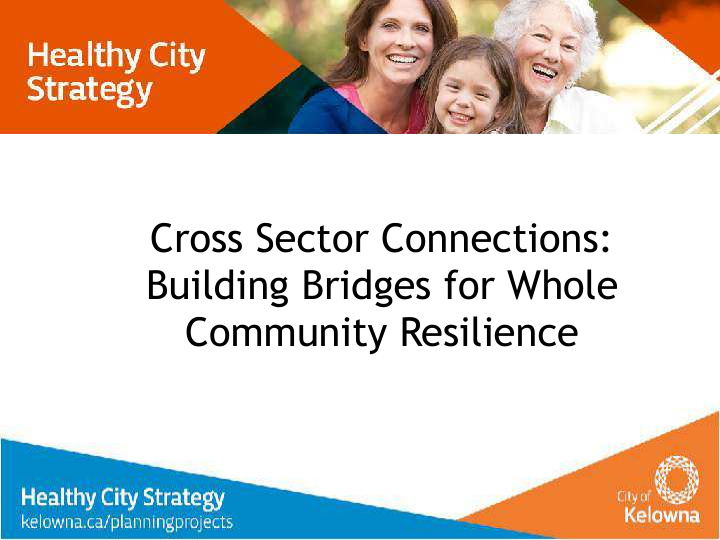



Cross Sector Connections: Building Bridges for Whole Community Resilience
Sustainable Urban Systems
Health Drivers • 2012 Ministry of Health mandate that HAs must work with LG to create communities where people can more easily make healthy choices. • Report quarterly on activity with LG partners. • Health lens to LG planning and policy. • Upstream systems/ planning v. downstream. • Work varies from parks and rec master plan to poverty reduction to consulting on energy and emissions plan.
Upstream/Downstream
Interior Health: we all have a role • Health Emergency Management • Epidemiologists • Medical Health Officers • Environmental Health Officers • Public Health Dietitians • Aboriginal Health Team • Community Health Facilitators • Healthy Built Environment Specialists • Energy and Environment Sustainability Department • Integrated Tobacco Program • Mental Health and Substance Use Program
Benefits of a Partnership • Exchange of knowledge and expertise • Public acceptance • Trust • Credibility • Public engagement • Synergies for mutually beneficial projects/research
Healthy City Strategy The Healthy City Strategy will be a long-term, integrative plan that will focus on healthy built environment, community health and quality of life for all Kelowna residents. Vision: Working together to create built environments in which people and places thrive.
Healthy City Strategy Theme areas Community for All
The IH – Kelowna Relationship
Guiding Principles 1. Prioritize the built environment 2. Integrate health in policies 3. Maximize partnerships for impact 4. Engage broadly for a healthy city 5. Lead and catalyze innovation 6. Embrace complexity
Moving Towards Trust
Complexity of Planning & an Uncertain Future • Governance – climate change and health is not a formal partnership • Partnership has created a nimble relationship • Investment in time, trust and expertise has created an ability to address complex issues together
The case for climate - flooding
The case for climate - drought 44 days without rain Drought could worsen C a s t a n e t , A u g 2 3 Capital News Aug 11 Okanagan Escalates to Drought Level 3, f o e g r Kelowna's on the verge of e v OBWB, Sep 1 n o r e m d m r having its longest drought u o s c y e r r D w Kelowna Daily Courier, Aug 10 e n g n ever , i t t e s KelownaNow, August 11 g n i d o o l f Drought conditions worsen in g n i r p s m o r F parts of southern B.C. t h g u o r d o e t Concerns raised over keeping stream h t n i s n o i t i d levels high enough for salmon and other n o c n fish to survive a g a n a k O CBC, Sept 8 InfoTel, Aug 23
The case for climate - fires s e u n 9 i t 1 n o g c u A y r , o s w s i e v d N a l a e t k i o p m a C S a n w o l e K Air Quality (pM2.5): 50.3 µg/m3
Future Trends 1. Climate trends • ~ 2 ° C temperature � • hot, dry summers • More rain, less snow 2. � drought 3. � flooding 4. � risk for pests 5. Economic impacts (e.g. agriculture, tourism) 6. Health impacts
Climate and Health
Community Climate Action Plans – Support Letters
Working Together – Case Study Partnership with FortisBC, City and Interior Health to promote the Environmental Conservation Assistance Program
Partnership w/Fortis – Case Study • Planning • Programs • Climate Action Plan • ECAP • Healthy Housing • Energy Diet Strategy • Rental Apartment • Funding Efficiency Program • Community Energy Advisor • CCAP
Charting a Path Forward
Recommend
More recommend